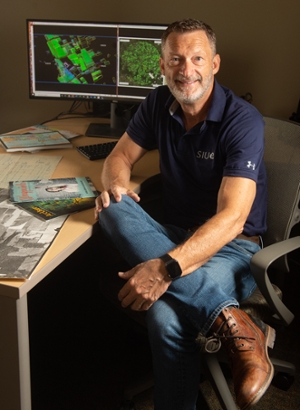SIUE’s GeoMARC Provides Innovative Geospatial Technology Solutions to St. Louis Area
 An innovative think-tank at Southern Illinois University Edwardsville, GeoMARC, is a leading geospatial technologies hub that is helping address both cultural and environmental issues facing the world.
An innovative think-tank at Southern Illinois University Edwardsville, GeoMARC, is a leading geospatial technologies hub that is helping address both cultural and environmental issues facing the world.
The applied research and development center specializes in the application of geographic information systems (GIS) and remote sensing. These technologies are crucial for researchers worldwide who are working to monitor and model the local, regional and national effects of natural disasters, map the hazardous locations along routes that children use to walk to school, predict potential subsidence due to underground mining, and conduct other important research that affects our day-to-day lives.
“GeoMARC capitalizes on the specialties of its multi-disciplinary staff who hold a wide range of geospatial expertise in remote sensing and digital image processing, GIS, machine learning, computer modeling, transportation network analysis, and solution automation,” said GeoMARC Director Randall Pearson, PhD.
GeoMARC continues to expand its impact as a nationally-recognized geospatial problem solver for local school districts, local area government, various state and federal agencies, and numerous commercial enterprises.
The Center has strong working relationships with SIUE’s Center for Predictive Analysis (C-PAN), the Biotechnology Incubator Laboratory (BLI) and NCERC. Additionally, GeoMARC has been awarded and completed more than 120 projects for local, state and government agencies, and Fortune 500 companies.
Current collaborations include:
- Illinois Department of Natural Resources: mapping and monitoring underground mines subsidence across Illinois
- Bayer Crop Science: modeling and mapping milkweed habitat important to monarch butterflies
- Illinois Corn Marketing Board: mapping the implications of land use change across the Midwest related to wind turbines
- Northwestern and the University of Illinois: providing data support for a machine learning approach to mapping wetlands and grasslands across Illinois
- Illinois State Library: providing population numbers and demographics for each of their 800+ libraries across the state
- BLI and C-PAN: pursuing a water quality project on Otter Lake in Illinois
“SIUE is uniquely positioned to host a center like GeoMARC due the Department of Geography’s expert faculty, high-quality students, and long-standing reputation across the region,” shared Pearson. “GeoMARC (formerly LASA) was formed in 1996, and has funded over 50 graduate students through assistantships and more than 150 undergraduates through student work. The workforce for the region is at SIUE, and GeoMARC has access to a highly-qualified pool of students.”
Students involved in GeoMARC gain refined geospatial technology skills and confidence in problem solving abilities. They learn how to build geospatial data sets, gather and clean data, design problem solutions, present solutions, and develop and refine interpersonal skills.
Pearson is confident the value of GeoMARC to SIUE and the community will continue to grow via cross-disciplinary and multi-institutional collaborations that promote the use of advanced geospatial technologies to conduct, lead and influence research and innovative solutions that meet the needs of both private industries and the public sector.
To get involved or learn more about GeoMARC, contact Pearson at rapears@siue.edu.
Photo: GeoMARC Director Randall Pearson, PhD.










